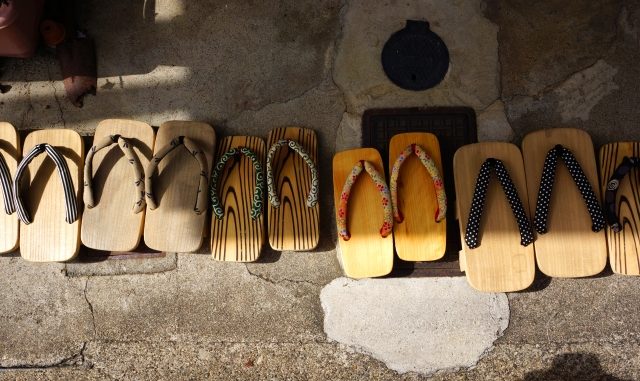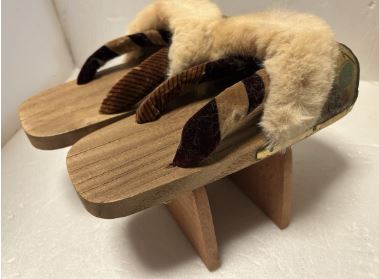
Japanese geta are a type of traditional footwear worn with kimonos and traditional Japanese clothing. For more information on zori, click here.
What are geta?
Geta are traditional Japanese footwear made of a wooden base made of paulownia or cedar, with one or two boards called teeth and a cloth strap called a hanao.
During Japan’s humid summers, wearing geta barefoot allows for good ventilation and comfort.
Even today, geta are a standard style for going to summer fireworks displays and festivals, with a yukata and barefooted footwear.
Geta, with their teeth, make a distinctive, light, clanging sound when walking.
History of geta:
In the past, geta were used as work tools. There were various types, including “ta geta” (field geta) for walking through muddy fields and ones for working in hot places.
Over time, geta became footwear for walking, and from the Muromachi period through the Edo period, they spread to common people and became everyday footwear.
During the Edo period, zori developed within townspeople’s culture and became a popular part of fashion.
Even today, they are widely worn with yukata (summer kimono) and other traditional Japanese clothing at festivals, hot spring resorts, and other events.
Differences from zori:
Zori, a similar type of footwear, are often worn with formal kimono and are paired with tabi socks. Their soles are made of soft materials like cork, leather, or cloth.
Geta are more casual, everyday footwear, often worn barefoot with summer attire like yukata and jinbei. Recently, some young people have begun pairing them with jeans.
Geta Structure:
The thong secures the foot, increasing stability. Furthermore, the “teeth” at the base lift the foot from the ground, protecting it from moisture and adapting to uneven surfaces.
Why wearing zori is good for your health:
The support part of the thong is held between the big toe and index toe.
The area between the big toe and index toe is home to many very important acupressure points for the eyes, brain, neck, and shoulders, which many modern people suffer from, such as brain and eye fatigue and stiff shoulders. These points can be stimulated every time you walk in your zori sandals with the thong between them.
When walking in geta, using your entire foot helps to develop appropriate calf muscles, which is said to be good for your health.
Tips for wearing geta properly:
To avoid pain caused by the thong rubbing against your feet, leave a gap between the thong and your toes to reduce friction.
For this reason, the correct way to wear geta is for your heel to extend about 1-2 cm beyond the base.
(If the thong feels too tight, gently pull it open before putting them on to make it easier to fit your feet.)
GETA especially for Snowy country:
雪下駄【YUKIGETA】

Yukigeta are special geta sandals that are used in winter in snowy regions and have metal fittings and leather toe pads to prevent slipping. Some have specially designed teeth to prevent snow from remaining on the feet when walking in shallow snow, and there were also “stylish” yukigeta sandals for women to wear on special occasions.
In snowy erea like Niigata or Hokkaido from the mid-Meiji period to the early Showa period, before rubber boots became common, women wore stylish and elaborate snow clogs with their formal attire.

Leave a Reply